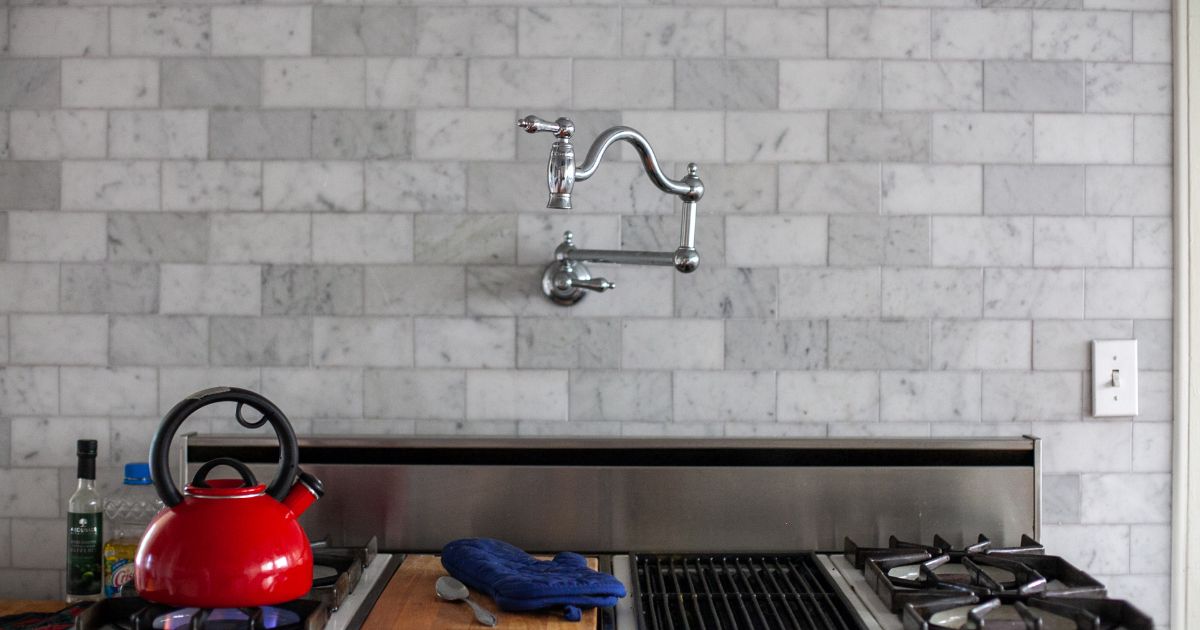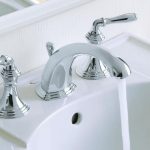Installing a pot filler faucet in your kitchen can be a great addition for any home cook. It allows for easy access to water while cooking, without having to carry heavy pots and pans to the sink. If you’re considering installing a pot filler faucet, it’s important to know the basics of installation to ensure success.
The installation process for a pot filler faucet can vary depending on whether you’re replacing an existing faucet or installing a new one. If you’re replacing an existing faucet, the process can be relatively straightforward. You’ll simply need to remove the old faucet and install the new one in its place. However, if you’re installing a new pot filler faucet where there wasn’t one before, the process can be more complex. You’ll need to ensure that there’s a water line running to the location where you want to install the faucet.
Understanding Pot Filler Faucets
If you love to cook, you know how important it is to have the right tools in your kitchen. One of the most useful tools for a home chef is a pot filler faucet. Pot filler faucets are designed to make it easy to fill pots with water without having to carry them from the sink to the stove. They are typically installed above the stove, so you can fill your pots without having to move them around.
Pot filler faucets come in a variety of styles and finishes, so you can choose one that matches your kitchen decor. They are also available in different heights, so you can find one that is the perfect height for your stove. When choosing a pot filler faucet, it is important to consider the size of your pots and the height of your stove. You want to make sure that the faucet is tall enough to reach your pots, but not so tall that it is difficult to use.
Pot filler faucets are typically installed on the wall above the stove. They are connected to the water supply and have a jointed arm that can be swung out to fill pots. Some pot filler faucets have two joints, which allows them to reach even further. When installing a pot filler faucet, it is important to make sure that it is securely anchored to the wall and that the water supply is properly connected.
Overall, pot filler faucets are a great addition to any kitchen. They make it easy to fill pots with water and can save you time and effort when cooking. If you are considering installing a pot filler faucet in your kitchen, make sure to choose one that is the right height and style for your needs.
Sure, here’s the section:
Choosing the Right Pot Filler Faucet
When it comes to choosing the right pot filler faucet, there are a few things to consider. First, you want to make sure that the faucet is the right height for your stove and the pots and pans you use. According to Kingston Brass, the general recommendation is to install the pot filler faucet 16 to 36 inches (40 centimeters to 1 meter) higher than the top surface of your range. If you mount it too low, you won’t be able to fit large pots under it.
Next, you want to consider the style of the pot filler faucet. There are many different styles available, from traditional to modern. You want to choose a style that complements the design of your kitchen.
Another important factor to consider is the finish of the pot filler faucet. You want to choose a finish that matches the other fixtures in your kitchen, such as your sink faucet and cabinet hardware. Popular finishes include chrome, brushed nickel, and oil-rubbed bronze.
Finally, you want to choose a pot filler faucet that is easy to use and maintain. Look for a faucet with a swivel spout that can be moved out of the way when not in use. You also want to choose a faucet that is easy to clean and doesn’t require a lot of maintenance.
By considering these factors, you can choose the right pot filler faucet for your kitchen that is both functional and stylish.
Sure, here’s the section you requested:
Tools and Materials Needed
Essential Tools
To install a pot filler faucet, you will need the following tools:
- Adjustable wrench
- Hole saw or drill bit (depending on the size of the installation hole)
- Tape measure
- Level
Required Materials
In addition to the tools listed above, you will also need the following materials:
- Pot filler faucet
- Matching supply lines with shut-off valves
- Silicone caulk and putty tape
Before beginning the installation process, make sure you have all of the necessary tools and materials listed above. This will ensure a smooth and successful installation process.
Positioning Your Pot Filler Faucet
When it comes to installing a pot filler faucet, one of the most important considerations is where to position it. The faucet needs to be placed in a location that is convenient for you to use, while also allowing you to easily fill pots of different sizes.
According to the experts at Kingston Brass, the general recommendation is to install the pot filler faucet 16 to 36 inches (40 centimeters to 1 meter) higher than the top surface of your range. If you mount it too low, you won’t be able to fit large pots under it. On the other hand, if you mount it too high, you may have trouble reaching it comfortably.
Another common placement for a pot filler faucet is directly above the burners. This centered position is ideal for larger pot filler designs, but you’ll want to ensure that it has good flexibility so that it can easily reach all areas of your stove.
When deciding on the exact placement for your pot filler faucet, consider the size of your pots and the height of your stove. In general, the faucet should be placed anywhere from 16 to 28 inches above the surface of the range top or stove. Try grabbing the biggest stockpot used on the stove and add at least three or four inches to its height.
Ultimately, the placement of your pot filler faucet will depend on your personal preference and the layout of your kitchen. Take your time to find the perfect spot that works best for you.
Drilling the Hole
Now that you have measured and marked the wall, it’s time to drill the hole for the pot filler faucet. You will need a hole saw or drill bit, depending on the size of the installation hole. Make sure you have the correct size before drilling.
Before drilling, turn off the water supply to the area where you will be drilling. You don’t want water spraying everywhere when you start drilling.
Next, use a level to make sure the hole will be straight. You don’t want a crooked pot filler faucet. Mark the center of the hole with a pencil.
Now, it’s time to drill. Start at a low speed and gradually increase as you go. Don’t apply too much pressure. Let the saw or bit do the work.
Once you have drilled the hole, clean up any debris. You don’t want anything getting in the way of the installation.
That’s it! You have successfully drilled the hole for your pot filler faucet.
Installing the Faucet
Installing a pot filler faucet can be a complex process, but with the right tools and instructions, it can be done easily. This section will guide you through the process of installing the faucet, including mounting the faucet and connecting the water supply.
Mounting the Faucet
To mount the faucet, you will first need to remove the old pot filler. Then, you can install the new mounting plate and attach the new faucet to the existing supply line. Make sure the mounting plate is level and securely attached to the wall. Follow the manufacturer’s instructions for mounting the faucet and ensure that it is properly aligned with your stove.
Connecting the Water Supply
If you are installing a new pot filler where there isn’t one, you will need to run a new water line to the location of the pot filler. This can be a complex process and may require the help of a professional plumber. If you are connecting the pot filler to an existing water line, make sure to turn off the water supply before making any connections.
Once the water supply is turned off, you can connect the pot filler to the water line using the appropriate fittings. Make sure all connections are tight and secure to prevent leaks. Turn the water supply back on and check for leaks. If you notice any leaks, turn off the water supply and tighten the connections.
That’s it! You have successfully installed a pot filler faucet.
Testing the Installation
Now that you have successfully installed your pot filler faucet, it’s time to test it out. Here are some steps to follow to ensure that your installation is working properly:
- Turn off the water supply to the pot filler faucet.
- Turn on the faucet and check for leaks at the connection points. If there are any leaks, tighten the connections until they are snug.
- Turn off the faucet and turn on the water supply to the pot filler faucet.
- Turn on the pot filler faucet and check for leaks again. If there are any leaks, turn off the water supply and tighten the connections until they are snug.
- Fill up a large pot with water and place it under the pot filler faucet. Turn on the faucet and let the water flow into the pot. Check to make sure that the pot filler faucet is working properly and that the water is flowing freely.
- Repeat the process with several different sized pots to ensure that the pot filler faucet is flexible enough to accommodate different pot sizes.
- Finally, turn off the pot filler faucet and turn off the water supply. Congratulations, you have successfully installed and tested your pot filler faucet!
Got it. Here’s a section on maintenance tips for your pot filler faucet installation:
Maintenance Tips
Once your pot filler faucet is installed, it’s important to keep it in good working condition. Here are a few maintenance tips to help you get the most out of your new fixture:
- Clean the faucet regularly: To keep your pot filler faucet looking shiny and new, wipe it down regularly with a soft cloth and mild soap. Avoid using abrasive cleaners or scrubbers that could scratch the finish.
- Check for leaks: Over time, the connections on your pot filler faucet may loosen, leading to leaks. To prevent this, check the connections periodically and tighten them as needed.
- Inspect the hose: The hose on your pot filler faucet should be flexible and easy to move. If you notice any kinks or cracks in the hose, it may be time to replace it.
- Keep the water supply lines clear: If you live in an area with hard water, mineral buildup can clog your pot filler faucet’s water supply lines. To prevent this, consider installing a water softener or using a descaling solution periodically.
By following these simple maintenance tips, you can keep your pot filler faucet in top condition for years to come.
Sure, here’s your section titled “Conclusion”:
Conclusion
Congratulations! You have successfully installed your pot filler faucet. Now, you can enjoy the convenience of having water readily available while cooking. Remember to always turn off the water supply when not in use to avoid any leaks or damages.
It is important to ensure that the pot filler faucet is installed at a suitable height and location, so it can be easily accessible and functional. Make sure to follow the manufacturer’s instructions and use the appropriate tools and materials for the installation process.
Regularly clean and maintain your pot filler faucet to ensure its longevity and optimal performance. Check for any leaks or damages and address them promptly.
Thank you for choosing to install a pot filler faucet in your kitchen. Enjoy your new addition and happy cooking!



